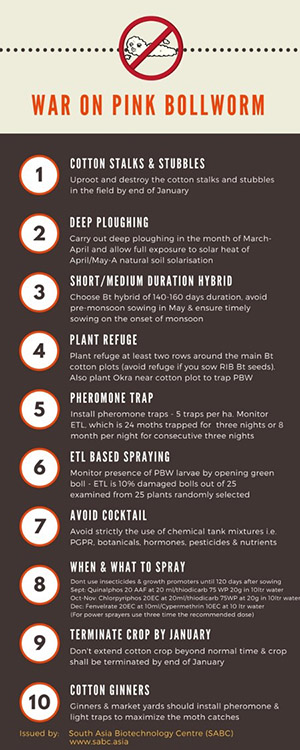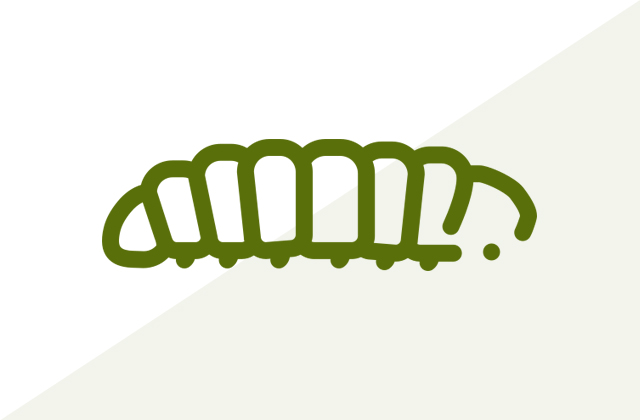Management Strategy
Pink Bollworm is a mysterious pest having unique ability to diapause as larva when the climate is unfavourable and become active during favourable conditions. PBW larva can survive in uprooted cotton stalks stored by farmers for fuel purpose as well. PBW larva can feed & multiply on the seed cotton stored in gins. Longer the storage, higher the propensity to multiply. The pink bollworm has made the situation difficult for farmers due to different time of emergence, pattern of occurrence and the scale of spread and thus can cause significant loss to cotton growers. The PBW used to infest at the later stage of crop, has recently been reported devouring crop at square/boll formation as early as 50-60 days of planting to harvesting across the cotton growing geographies.
Management of the Pink Bollworm:
Four Easy Steps to Control Pink Bollworm
- Grow Short/Medium Duration Hybrid
- Plant Refuge
- ETL Based Spraying
- Terminate Crop by January
There are two aspects of management of PBW. The first one involves pre-cultivation and post-harvest strategies while the second involves the field management of crop.
- Pre-Cultivation and Post-Harvest Strategies
- Post Planting Strategies
A. Pre-Cultivation and Post-Harvest Strategies:
Deep ploughing, grow short duration hybrids & Refuge planting
- Cotton crop sowing commences on onset of monsoon mostly in June-July in in Central and Southern India. It is recommended that the previous crop is terminated by end of January or maximum by mid-February. After termination of crops it is necessary to utilise the stalks for other purposes such as briquettes or pellet making. Since this year there has been epidemic outbreak of PBW, it is suggested to have two deep ploughings in summer to destroy all crop residues to obtain full advantage of soil solarisation.
- Install light traps or pheromones traps near godowns, ginneries, market yard to trap post season moths.
- Stop use of untested, unauthorised seeds of cotton. Select only hybrids/varieties which have been recommended and only from those companies who have regular R&D facilities. Also test trait purity of Bt cotton supplied by companies as easy quick tests are available. Avoid sowing pre-monsoon crop and select only hybrids/varieties of 140-160 days duration which are resistance to sucking pests.
- Timely sowing on ridges and furrows on the onset on monsoon. Strictly follow planting of non-Bt cotton seeds around the Bt cotton as a refugia crop which are supplied with Bt cotton seeds. In fact refugia in bags (RIB) concept has been tested and approved by Ministry of Agriculture and Farmers’ Welfare and must be adopted on large scale.
B. Post Planting Strategies
ETL based spraying and timely termination of crop by January
- Regular scouting and management of PBW pest for taking timely initiative of ETL-based control measures. Pheromone traps at the rate of 4-5 traps per ha should be installed for monitoring. When 24 moths per trap over observed, the economic threshold level (ETL) has reached to consider taking measures of control such as use of Trichoderma or Bracon biocontrol agents or application of safe insecticides should be initiated.
- Do not spray any synthetic pyrethroid till 80 days of crop or any kind of mixture of insecticides. Insecticides such as quinalphos or thiodicarb may be used in early stages of crop growth at the rate of 20ml quinalphos or 20g thiodicarb per 10 litres of water.
- In Oct-Nov, if the ETL is crossed then spray thiodicarb 74% 350 gms per acre, Fubendamide 50 Ml per acre or Deltamethrin 50 ml per Acre or chlorpyriphos 20% EC as 25ml.
- Do not use any growth promoting chemicals, or other substances including urea during grand growth to avoid greenness and succulence of foliage. Several chemicals such as monocrotophos, acephate, thiomethoxans, acetamiprid, imidachloprid or chlothinidin should be avoided in early stages of crop growth as their application results in halting squares-flower formation by extending vegetative phase. Delayed maturity attracts more damage from PBW.
- By end of Nov-Dec when cotton grows beyond 120 days, then at ETL, fenvelret 20% EC or cypermethrin 10% EC at 10ml per 10 litre water can be applied to check the spread the PBW (Tip: For power spray, the dose of insecticide shall be three times more).
- It is desirable to have collective use of pheromone traps through community groups on farms so that real success of monitoring is achieved.






